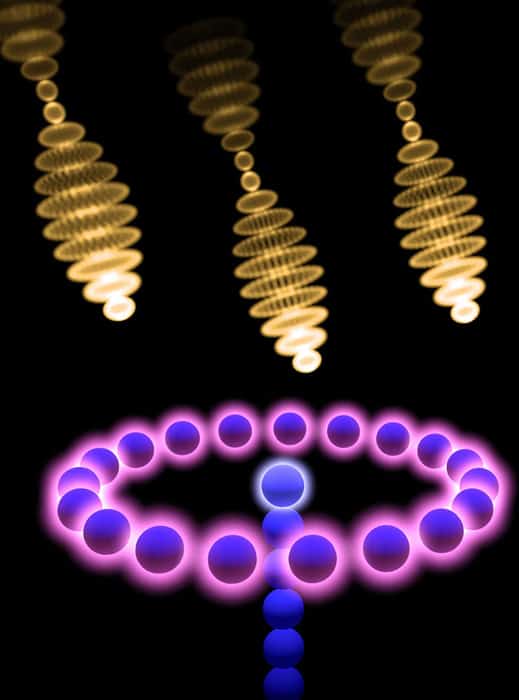
Rings of excited atoms that harness a quantum effect to absorb light at an enhanced rate could be used in future technologies such as highly sensitive cameras, solar cells and systems for optical power transmission. That is the claim of researchers in Australia, Singapore and the UK, who have done calculations that show that the well-known quantum phenomenon of superradiance could be used to create a new type of optical absorber.
First discovered 60 years ago by the US physicist Robert Dicke, superradiance occurs when a group of N emitters of light – such as atoms, molecules or quantum dots – emit at a rate that is proportional to N2. This is a much higher rate than is predicted by classical physics.
Emission and absorption are related processes, and this means that systems that superradiate must also be very good at absorbing light: an effect that the researchers dub “superabsorption”. As a result, closely spaced atoms can absorb collectively, making it impossible to tell which specific atom absorbs any given photon. When the group absorbs a photon, it is in a quantum superposition of all the possible excited states. This is known as a Dicke state. Similarly, subsequent absorptions lead to further Dicke states – each a superposition covering all the possible ways in which the total number of excitations might have occurred.
Exploring pathways
“This is why the absorption/emission rates are enhanced,” says Kieran Higgins of the University of Oxford, who did the calculations along with colleagues at Oxford, the University of St Andrews, the National University of Singapore and the University of Queensland. “Quantum mechanics tells us that all these possible pathways will be explored; so if there are many ways for a particular event to happen, its probability – and thus its rate – is enhanced commensurately.”
Together, these Dicke states form a kind of “ladder” – one with unevenly spaced rungs – of different rates of absorption. Higgins explains that the mid-point of the ladder provides the optimum absorption rate, “because the state with half the atoms excited has the largest number of possible ways to compose it”. For the purposes of taking advantage of the maximum absorption, then, the challenge lies in ensuring that – once charged up to the mid-point by a laser – the atoms remain excited, rather than trending back towards the bottom-most state.
The researchers’ solution to this problem makes use of ring molecules. This was inspired by similar rings used by plants to capture light during photosynthesis, albeit not involving such excited states. The ring geometry ensures that each rung on the Dicke ladder has a unique frequency of light that it can absorb or emit. The team has shown that quantum control techniques could be used to enhance or suppress the transitions between states to keep the system at the desired rung.
Simple filters
This could be realized in the lab by placing the superabsorber into an environment – such as a photonic-crystal cavity or photonic band-gap crystal – that limits the unwanted transitions that lie away from the mid-point. “Alternatively, the simplest proposal would be just to filter the light you shine onto the superabsorber,” adds Higgins, “although this requires more frequent resetting of the system.”
With the absorption being maintained at the optimum rate, a charge sensor such as a quantum point contact would allow the system to be used as a photon sensor. Alternatively, a nanowire could be used to create an irreversible trap to extract surplus energy; this approach could be used in solar-energy and optical-energy-transmission technologies.
It is only a matter of time before such “quantum engineered” systems will replace the classical systems we use today
Maarten Hoogerland, University of Auckland
Maarten Hoogerland, a physicist from the University of Auckland, commends the paper for its “innovative, outside-the-box thinking”, and notes that – while there will be practical hurdles to overcome – the principle might well be implementable in coming years. “As device-manufacturing techniques get better and easier,” he adds, “it is only a matter of time before such ‘quantum engineered’ systems will replace the classical systems we use today.”
“The time is ripe for learning how to harness quantum-mechanical collective behaviour to enhance and direct physical processes in ways not possible with classical physics,” agrees Michael Raymer, an optical physicist from the University of Oregon. “If energy transport could be engineered through the coherent collective effects in molecular systems, it would lead to numerous breakthroughs in science and engineering.”
The research is described in Nature Communications and a preprint is available on arXiv.



